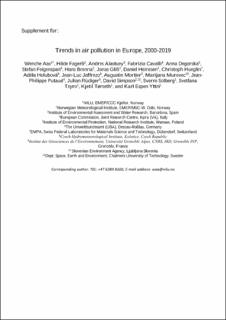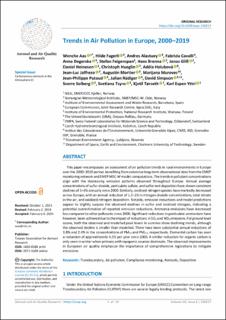| dc.contributor.author | Aas, Wenche | |
| dc.contributor.author | Fagerli, Hilde | |
| dc.contributor.author | Alastuey, Andres | |
| dc.contributor.author | Cavalli, Fabrizia | |
| dc.contributor.author | Degorska, Anna | |
| dc.contributor.author | Feigenspan, Stefan | |
| dc.contributor.author | Brenna, Hans | |
| dc.contributor.author | Gliss, Jonas | |
| dc.contributor.author | Heinesen, Daniel | |
| dc.contributor.author | Hueglin, Christoph | |
| dc.contributor.author | Holubová, Adela | |
| dc.contributor.author | Jaffrezo, Jean-Luc | |
| dc.contributor.author | Mortier, Augustin | |
| dc.contributor.author | Murovec, Marijana | |
| dc.contributor.author | Putaud, Jean-Philippe | |
| dc.contributor.author | Rüdige, Julian | |
| dc.contributor.author | Simpson, David | |
| dc.contributor.author | Solberg, Sverre | |
| dc.contributor.author | Tsyro, Svetlana | |
| dc.contributor.author | Tørseth, Kjetil | |
| dc.contributor.author | Yttri, Karl Espen | |
| dc.date.accessioned | 2024-03-20T15:07:01Z | |
| dc.date.available | 2024-03-20T15:07:01Z | |
| dc.date.created | 2024-02-19T16:33:31Z | |
| dc.date.issued | 2024 | |
| dc.identifier.citation | Aerosol and Air Quality Research. 2024, 24, 230237. | en_US |
| dc.identifier.issn | 1680-8584 | |
| dc.identifier.uri | https://hdl.handle.net/11250/3123471 | |
| dc.description.abstract | This paper encompasses an assessment of air pollution trends in rural environments in Europe over the 2000–2019 period, benefiting from extensive long-term observational data from the EMEP monitoring network and EMEP MSC-W model computations. The trends in pollutant concentrations align with the decreasing emission patterns observed throughout Europe. Annual average concentrations of sulfur dioxide, particulate sulfate, and sulfur wet deposition have shown consistent declines of 3-4% annually since 2000. Similarly, oxidized nitrogen species have markedly decreased across Europe, with an annual reduction of 1.5-2% in nitrogen dioxide concentrations, total nitrate in the air, and oxidized nitrogen deposition. Notably, emission reductions and model predictions appear to slightly surpass the observed declines in sulfur and oxidized nitrogen, indicating a potential overestimation of reported emission reductions. Ammonia emissions have decreased less compared to other pollutants since 2000. Significant reductions in particulate ammonium have however, been achieved due to the impact of reductions in SOx and NOx emissions. For ground level ozone, both the observed and modelled peak levels in summer show declining trends, although the observed decline is smaller than modelled. There have been substantial annual reductions of 1.8% and 2.4% in the concentrations of PM10 and PM2.5, respectively. Elemental carbon has seen a reduction of approximately 4.5% per year since 2000. A similar reduction for organic carbon is only seen in winter when primary anthropogenic sources dominate. The observed improvements in European air quality emphasize the importance of comprehensive legislations to mitigate emissions. | en_US |
| dc.language.iso | eng | en_US |
| dc.rights | Navngivelse 4.0 Internasjonal | * |
| dc.rights.uri | http://creativecommons.org/licenses/by/4.0/deed.no | * |
| dc.title | Trends in Air Pollution in Europe, 2000–2019 | en_US |
| dc.type | Peer reviewed | en_US |
| dc.type | Journal article | en_US |
| dc.description.version | publishedVersion | en_US |
| dc.rights.holder | © The Authors. | en_US |
| dc.source.pagenumber | 35 | en_US |
| dc.source.volume | 24 | en_US |
| dc.source.journal | Aerosol and Air Quality Research | en_US |
| dc.identifier.doi | 10.4209/aaqr.230237 | |
| dc.identifier.cristin | 2247730 | |
| dc.relation.project | Sigma2: nn2890 | en_US |
| dc.relation.project | Norges forskningsråd: 229796 | en_US |
| dc.relation.project | FNs økonomiske kommisjon for Europa (UNECE): EMEP programme under CLRTAP | en_US |
| dc.relation.project | Sigma2: ns9005k | en_US |
| dc.relation.project | NILU: 7726 | en_US |
| dc.relation.project | Klima- og miljødepartementet: 19657200 | en_US |
| dc.source.articlenumber | 230237 | en_US |
| cristin.ispublished | true | |
| cristin.fulltext | original | |
| cristin.fulltext | original | |
| cristin.qualitycode | 1 | |


